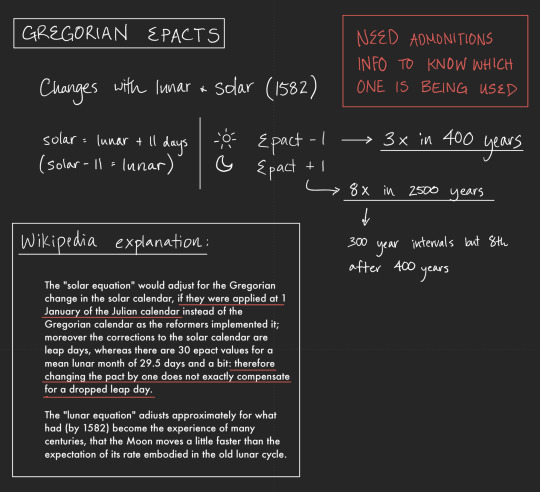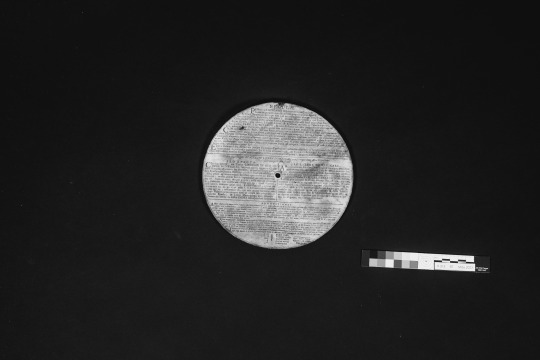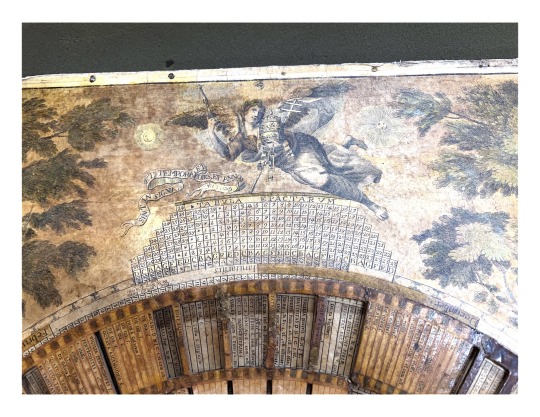Calendarium Perpetuum Ecclesiastico Civile. Turin, Italy, 1745.
Don't wanna be here? Send us removal request.
Text

one of the most challenging aspects of this piece is the question of alignment. that is, how does one "set" the outer ring's position? and the same question stands for the inner ring as well.
having translated all of the text and grasped the mathematical principles behind the calculations in question, I've spent the past month mulling on the problem of alignment.
following the example given in the calendar's central inscription, I have attempted to decipher the mechanics for the year of 1746. namely, in the year 1746, Easter purportedly fell on the date of April 10. could I retrace the path that arrived at that calculation with the equations and knowledge I've gleaned from the calendar's text?
with the assistance of the Dominical letters table and the equations previously discussed, one can determine the following values (that also happen to be given by the calendar's central inscription):
the golden number of 1746 is 18 the "Dominical number" is 19* the Dominical letter is b. * while not explicitly denoted as such in the calendar's instructions, this is the term I have adopted for ease of reference. it is the number one calculates to determine the Dominical letter.
it was my initial instinct that the marker for the outer ring was meant to be aligned with the table of epacts that appears at the top of the great circle. not only is the table of epacts affixed on the great circle, but the neat grid pattern accounts for a size such as can be found with the outer circle's marker.
being rather illiterate in the complex mechanics of the religious calendar of Catholicism, I am uncertain regarding the progression of the outer circle's marker across the table of epacts; there is certainly a sequential nature implied by the structure of the table, but the details for such are contained both in this calendar's inscription of "admonitions" as well as elsewhere in literature about the Catholic calendar.
aligning the outer ring with the first instance of the Dominical letter in question—b—presumably reveals the designation of days throughout the year. however, more importantly for my purposes, the more profound discovery occurred when I also aligned the inner ring to also point at the same entry of b in the table of epacts.
the outer and inner rings aligned accordingly, one sees that the full moon in the month of April can be approximately construed* to fall on April 9. this is critical because, according to archival sources, April 9, 1746 was, indeed, a full moon, and it is what prompted April 10 to be the date of Easter for that year, as it was the first Sunday following the first full moon that occurred on or after the spring equinox (also known, for the purposes of the Church, as the ecclesiastical equinox).
* I say "approximately construed" with an abundance of caution. the physical status of the calendar exhibits signs of wear, especially as the two moving circles are made out of wood and/or paper. it is reasonable to assume that the original alignment of the circles within themselves has not been maintained through the centuries, including the exact positioning of the markers. the small discrepancy in this particular example may be evidenced in photo accompanying this post.
the image included with this post was created by me through a series of manipulations in Adobe Photoshop 2023. as previously discussed, the MSU library's own conservation lab took photographs of the deconstructed item in question. using these high resolution images of the discrete pieces, I was able to cut out and layer the images together to crudely fashion what may generously be called a virtual representation of the calendar with its two moving circles. the image depicting the base of the calendar was skewed, hence the overall skewed presentation of my digital pastiche illustrating my example.
to say that I am thrilled (and relieved!) to have made such strides in understanding such a unique and complex artefact would be a gross understatement. it's been a challenge that has tested my mettle in ways I never expected, but I'm grateful for the opportunity to handle and learn from such an intriguing piece.
armed with the mostly-success of my test datapoint with the year 1746, I plan to conduct more testing to gather more data and to better understand the process as it was intended from start to finish. I anticipate also wrestling with how solar and lunar anomalies must be accounted for, as a good deal of the calendar's "admonitions" address such exceptions. I suspect that a large part of this may be to gain a better understanding of the role of the number of epacts in a given year and what happens in "extreme" cases (i.e., when the golden number is 0, leap years, and when epacts "reset").
#rare books#special collections#epacts#academia#turin#msu#library#michigan state university#italy#easter#latin#old books#rbms
3 notes
·
View notes
Photo


after further investigation into the additional notes in the Dominical Letters table, I have surmised that they refer to the distinction between the Julian and Gregorian calendars.
And according to the old calendar, up to 1582.
And from the year of correction up to 1700.
regarding the lower left declaration, in addition to naming the piece as the perpetual calendar for both Church and civil life, there is a reference to Leviticus 23-4. the beginning of the third line is illegible, but one may deduce that, in all likelihood, the third line begins with temporibus.
These, then, are the holy days of the Lord, which you must celebrate at their times.
#latin#translation#calendar#rare books#special collections#italy#italian#catholic#liturgy#leviticus#bible#msu#michigan state university#easter#epacts#holy days#julian calendar#gregorian calendar
1 note
·
View note
Photo

with many thanks to u/lbrey and u/jejwood from the wonderful reddit.com/r/latin, I have just recently managed to cobble together a translation of the admonitions portion of the instructions.
A leap year has two letters, of which the first flourishes from 1 January continuously to 24 February inclusive. The other all the way to the end of the year. Accordingly, January will be the style adapted of the first letter, from which a step will be made on 25 February, to another, which must follow immediately, this second [one] staying with the epacts; for it is no concern because passing through, however rarely, this is evident from 1 January to 24 February, the first [letter] does not stay, for the second letter is has its own of the year, because it obtains the larger part [of the year]. And because it is the main thing, to look to the Passover to rule, from which the rest of the moving [feasts] receive the law.
No letter has twice the same number of epacts, except D, which has two locations 24 and 25. In this case, when the Dominical letter D should happen with the epacts 24 or 25, the second D should always be accepted, except if it has been a leap year, that is, D [?]. C: in whose case it must be accepted D is placed in the first position.
There are some feasts, or solemnities which are neither properly movable nor properly immovable (for those are properly called movable whose date depends on that of Easter); therefore for the churches of Turin the time is assigned as follows.
The Second Sunday after Epiphany is the Feast of the the Most Holy Name of Jesus, 2nd Class, with a commemoration of the Sunday: Sunday within the octave of the Feast of the Assumption is the Feast of St Joachim, duplex major, with a commemoration of the Sunday and of the Octave day: The second Sunday of August is the Feast of the Most Holy Sacrament, duplex major, commemoration of the Sunday: Sunday within the Octave of the Feast of the Nativity of the Blessed Virgin Mary is the Feast of the Most Holy Name of the same (i.e. the BVM), duplex major, commemoration of the Sunday: Sunday in the kalends of October, or the 1st Sunday after, is the Solemnity of the Most Holy Rosary, duplex major, commemoration of the Sunday:
The circle of movables indicates the spring and summer ember days, but those of autumn are celebrated on the Wednesday, Friday, and Saturday after the Feast of the Exaltation of the Holy Cross [these are the ember days], and those of winter after the third Sunday of Advent, but the Sunday after the 26th of November will be the 1st Sunday of Advent.
Denotes: 1.cl. = first class 2.cl. = second class Maj. = two times as large D = two times as small S = half of two times
Printed by Peter Joseph Zappata, & sons
as one may observe, the admonitions for the liturgical calendar are exceedingly complex. I was pointed towards B. Hausmann’s Learning the Breviary (1932) as a means for learning more about the history of the Catholic calendar and the ranking of feasts and sundry.
regarding the calendar’s provenance, the name of Zappata is an excellent lead to follow for learning more about the craftsmen who made this piece.
now that we have the instructions, the next steps will be to attempt putting them into practice. more on that to come.
#latin#catholic#liturgy#saints#scholarship#academia#rare books#special collections#msu#michigan state university#turin#italy#calendar#easter#holy feasts#provenance
2 notes
·
View notes
Photo


as I have been learning about the historical traditions for calculating epacts, I have extracted the relevant equations. however, as one may observe, there are differing ‘techniques’ for calculating epacts. it is not immediately apparent to me which protocol the piece in question follows. once again, this will likely be resolved once I have translated the “ADMONITIONS” portion of the instructing text.
#special collections#rare books#perpetual calendar#italy#turin#scholarship#goodnotes#epacts#easter#gregorian calendar#lunar#solar#msu#michigan state university#library#libraries#librarian#investigation#latin#translation
3 notes
·
View notes
Photo

examining the instructions, particularly the details for determining the golden numbers and the Dominical letters, I have produced an approximate translation. while the translation is certainly not refined, it captures the essence of the knowledge needed to utilise the relevant information.
The shorter circle, whose title is "THE CIRCLE WHEREIN [are] THE GOLDEN NUMBERS", contains the golden numbers in the form of Roman numerals so arranged, as for the various Epacts of the centuries, and in the below cells is presented the letter of martyrology. These positions are to find, after the Epact is found, the golden numbers. However, the method to know these golden numbers is concise: The numbers of the year, of which you inquire, add a single unit, divide the resulting sum by 19, and what is left is the golden number of the same year. If there is nothing remaining, the golden number is 19. For example, 1746. Add 1. Divide the resulting sum by 19, and the remaining is 18, which is the golden number of the year 1746. So, the golden number will be in the cell below the position found by the Epact. And the purpose of the letter of martyrology, provided that the word corresponds with the INDEX by the hundredth.
For the Domincal Letters. To find the Domincal letter of each year is the same proportion, and in this manner the golden number. The number of which you inquire, add 9. Divide the resulting sum by 28, and for the remainder consult the first column of the table, whose title is "THE TABLE OF DOMINCAL LETTERS", which stands to the lower left side. And so, I say, the number will be shown exactly by the region of the year in question. However, if there is nothing remaining, it will be found from the area by the last number 28. For example, 1746. Add 9. Divide the resulting sum by 28, and the remaining is 19, the number in this case provided by the table, the letter of the year 1746, which will be the letter B. It must be observed, from the seven columns of the letters are arranged for the differing ages, which stands the hundredth.
of particular note, the bottom-most portion of the instructions appears to provide vital information for the broader use of the perpetual calendar as it contains details regarding information such as leap years. I have not yet translated this portion of the text but it is my next task.
#msu#library#libraries#special collections#rare books#michigan state university#librarians#perpetual calendar#turin#italy#easter#epacts#golden numbers#domincal letters#academia#scholarship#latin#translation
0 notes
Photo






more detailed images better displaying the details of the piece. the images are gathered from both the library’s own conservation laboratory and my own photos and scans of the piece in question. using Lightroom, black and white filters were applied to the laboratory’s high quality .nef files in order to draw out the details of the text and inscriptions for ease of virtual inspection.
#special collections#library#librarian#rare books#perpetual calendar#golden numbers#epacts#easter#domincal letters#italy#turin#academia#librarians#msu#michigan state university#scholarship
2 notes
·
View notes
Photo


the first look at this intriguing piece! originally purchased from Bernett Books in Boston, MA. observe the green arsenic within the smaller of the moving circles. inscriptions are all in Latin. transported to its current home the old-fashioned way (i.e., person and car).
Michigan State University Libraries, Stephen O. Murray and Keelung Hong Special Collections.
#special collections#perpetual calendar#golden numbers#domincal letters#epacts#easter#rare books#italy#turin#academia#library#librarians#msu#michigan state university
1 note
·
View note